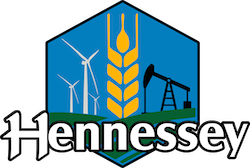Attractions
About Hennessey, Oklahoma
Located in north-central Kingfisher County at the intersection of U.S. Highway 81 and State Highway 51, Hennessey was born with the run into the Unassigned Lands of central Oklahoma. Kingfisher, the county seat, lies eighteen miles to the south. In presettlement years various Plains tribes traversed the region in their search for buffalo and other game. Nearby, Turkey Creek is a tributary of the Cimarron River.

Pat Hennessey Park
The Pat Hennessey Memorial Park can be found at Iowa and Arapaho streets. The location of his body is another story. Pat Hennessey was originally buried next to the location of his death in a shallow grave. Rocks were placed over his body, and teamsters passing by would continue to place markers on his grave. At some point in history Hennessey's body was moved. It is possible his relatives came from Ireland and reclaimed his body. In any case, it is not at the marker site at Memorial Park: excavations there produced no remains.

Roy V Cashion Statue
The Roy Cashion Memorial statue is located in Memorial Park on the west side of Highway 81 in Hennessey, Oklahoma.
Roy V. Cashion
1st Okla. Vol. U.S. Cavalry
After his regiment helped in the victory at Las Quasiman, Cuba. he was killed as he charged over San Juan Hill. July 1, 1898 in the Spanish-American War.
This Oklahoma boy - Hennessey High School graduate - rode horse-back to Gurhrie, and enlisted on May 5, 1898, in "Rough Riders" under Col. Theodore Roosevelt.

Baker's Ranch
Located 2 miles south of Hennessey, OK on Highway 81 on the west side of road.
Site one-half mile west, this ranch station, noted watering place on the Old Chisholm Trail, was attacked in the last Indian war and found deserted a few days later, July 5m 1874, by Indian Agent J. D. Miles who asked for U. S. Cavalry to guard the trail in this section. This site was laid out in 1890 as Baker City, a ghost town now.

Bull Foot Station
Off Of Highway 81 south edge Hennessey, Ok, Main and 9th Street, follow street around in Park until you see the monument on the west side of street
On the old Chisholm Trail, this station was noted for its water well. The name , from a huge indentation in the ground here resembling inprint of a Bull's Foot. Buildings were still standing on site, 50 yards east of the old trail, and 4.5 miles south of the north line of the Oklahoma Land which was opened to settlers by the Great Run, April, 22, 1889
